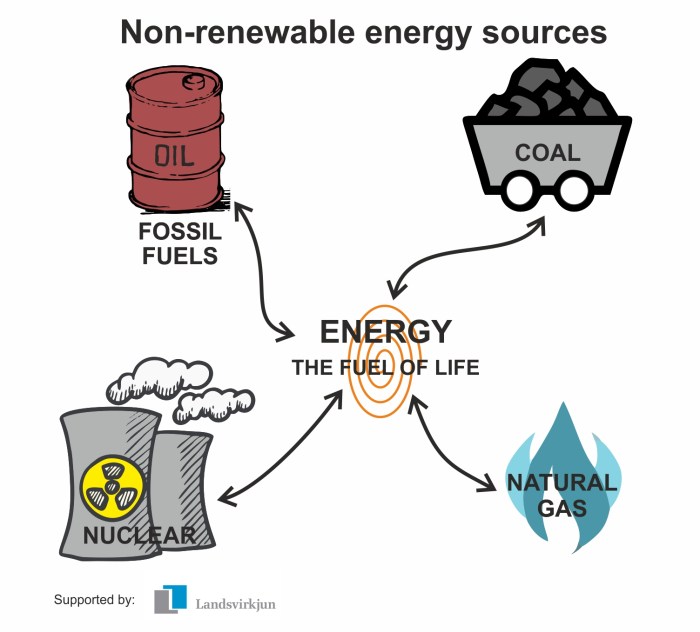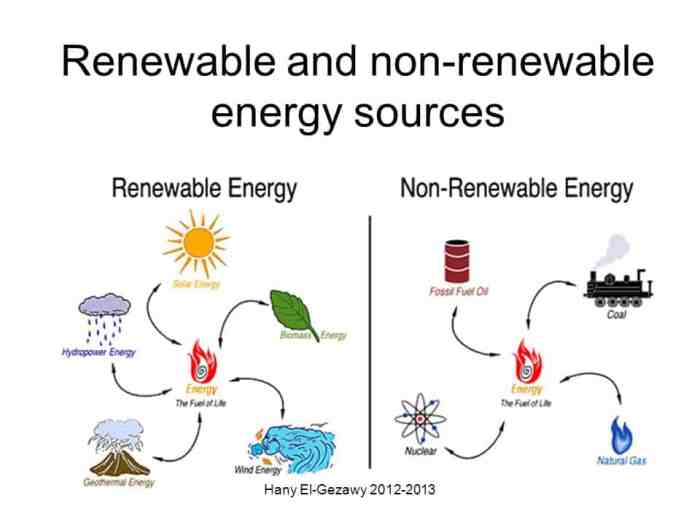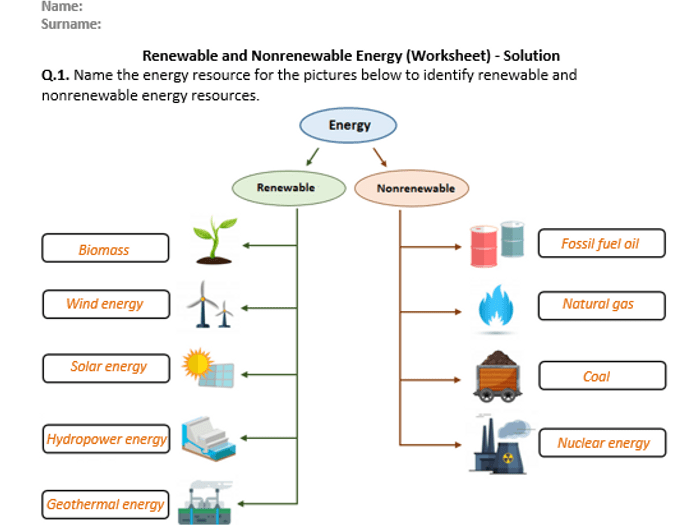Energy webquest- nonrenewable and renewable energy answer key – Embark on an enlightening journey with our comprehensive energy webquest, where we unravel the intricacies of nonrenewable and renewable energy. This interactive guide delves into the definitions, examples, advantages, disadvantages, and compelling statistics surrounding these crucial energy sources, empowering you with a profound understanding of their significance in shaping our energy landscape.
As we delve deeper, we will explore the stark contrasts between nonrenewable and renewable energy, highlighting their availability, reliability, environmental impact, and cost. Through this comparative analysis, you will gain invaluable insights into the key differences that define these two energy types.
Nonrenewable Energy

Nonrenewable energy refers to energy sources that cannot be naturally replenished over a human timescale. These sources are formed over millions of years and have a finite supply.
Examples of Nonrenewable Energy Sources
- Fossil fuels (coal, oil, natural gas)
- Nuclear energy
Advantages of Nonrenewable Energy, Energy webquest- nonrenewable and renewable energy answer key
- High energy density
- Reliable and consistent supply
Disadvantages of Nonrenewable Energy
- Depletion of finite resources
- Environmental pollution and climate change
- High extraction and production costs
Facts and Statistics about Nonrenewable Energy Consumption
- Fossil fuels account for over 80% of global energy consumption.
- The United States is the world’s largest consumer of nonrenewable energy.
- The burning of fossil fuels is a major contributor to greenhouse gas emissions.
Renewable Energy

Renewable energy refers to energy sources that can be naturally replenished on a human timescale. These sources are derived from ongoing natural processes and are virtually inexhaustible.
Examples of Renewable Energy Sources
- Solar energy
- Wind energy
- Hydropower
- Geothermal energy
- Biomass energy
Advantages of Renewable Energy
- Sustainable and environmentally friendly
- Reduced greenhouse gas emissions
- Decentralized and locally accessible
Disadvantages of Renewable Energy
- Intermittency and variability
- Higher upfront costs
- Land use requirements
Facts and Statistics about Renewable Energy Production
- Renewable energy accounts for over 25% of global electricity generation.
- Solar and wind power are the fastest-growing renewable energy sources.
- The International Energy Agency (IEA) predicts that renewable energy will account for over 50% of global energy supply by 2050.
Comparison of Nonrenewable and Renewable Energy

| Characteristic | Nonrenewable Energy | Renewable Energy |
|---|---|---|
| Availability | Finite | Virtually inexhaustible |
| Reliability | Reliable and consistent | Intermittent and variable |
| Environmental impact | Significant pollution and greenhouse gas emissions | Minimal pollution and low carbon footprint |
| Cost | Lower upfront costs, but higher long-term costs | Higher upfront costs, but lower long-term costs |
Key Differences between Nonrenewable and Renewable Energy
The key differences between nonrenewable and renewable energy lie in their availability, reliability, environmental impact, and cost. Nonrenewable energy sources are finite and have a limited supply, while renewable energy sources are naturally replenished and virtually inexhaustible. Nonrenewable energy sources are reliable and consistent, but they have a significant environmental impact due to pollution and greenhouse gas emissions.
Renewable energy sources are intermittent and variable, but they have a minimal environmental impact and low carbon footprint. The upfront costs of renewable energy are higher than nonrenewable energy, but the long-term costs are lower.
Energy Conservation: Energy Webquest- Nonrenewable And Renewable Energy Answer Key
Energy conservation refers to the practices and measures taken to reduce energy consumption and improve energy efficiency. It is an important aspect of sustainable energy management and can help mitigate climate change.
Importance of Energy Conservation
- Reduces greenhouse gas emissions
- Lowers energy costs
- Enhances energy security
Tips and Strategies for Conserving Energy in Daily Life
- Turn off lights when leaving a room.
- Unplug electronic devices when not in use.
- Use energy-efficient appliances and light bulbs.
- Insulate your home properly.
- Use public transportation, walk, or bike instead of driving whenever possible.
Role of Technology in Promoting Energy Efficiency
- Smart thermostats
- Energy-efficient lighting systems
- Renewable energy microgrids
Future of Energy

The future of energy lies in the transition to a sustainable and low-carbon energy system. Renewable energy sources are expected to play a dominant role in meeting future energy demands.
Potential of Renewable Energy in Meeting Future Energy Demands
- Solar and wind power are becoming increasingly cost-effective.
- Advances in energy storage technologies are improving the reliability of renewable energy.
- Government policies and incentives are promoting the adoption of renewable energy.
Emerging Technologies and Advancements in Renewable Energy Production
- Perovskite solar cells
- Floating wind turbines
- Concentrated solar power
Insights on the Transition to a Sustainable Energy Future
The transition to a sustainable energy future requires a combination of technological advancements, policy support, and public engagement. By investing in renewable energy research and development, implementing supportive policies, and raising awareness about energy conservation, we can create a cleaner and more sustainable energy system for future generations.
Helpful Answers
What is the primary distinction between nonrenewable and renewable energy?
Nonrenewable energy sources are finite and will eventually deplete, while renewable energy sources are replenished naturally over time.
Name three examples of nonrenewable energy sources.
Coal, natural gas, and oil.
What is a key advantage of renewable energy over nonrenewable energy?
Renewable energy sources are environmentally friendly and do not contribute to greenhouse gas emissions.